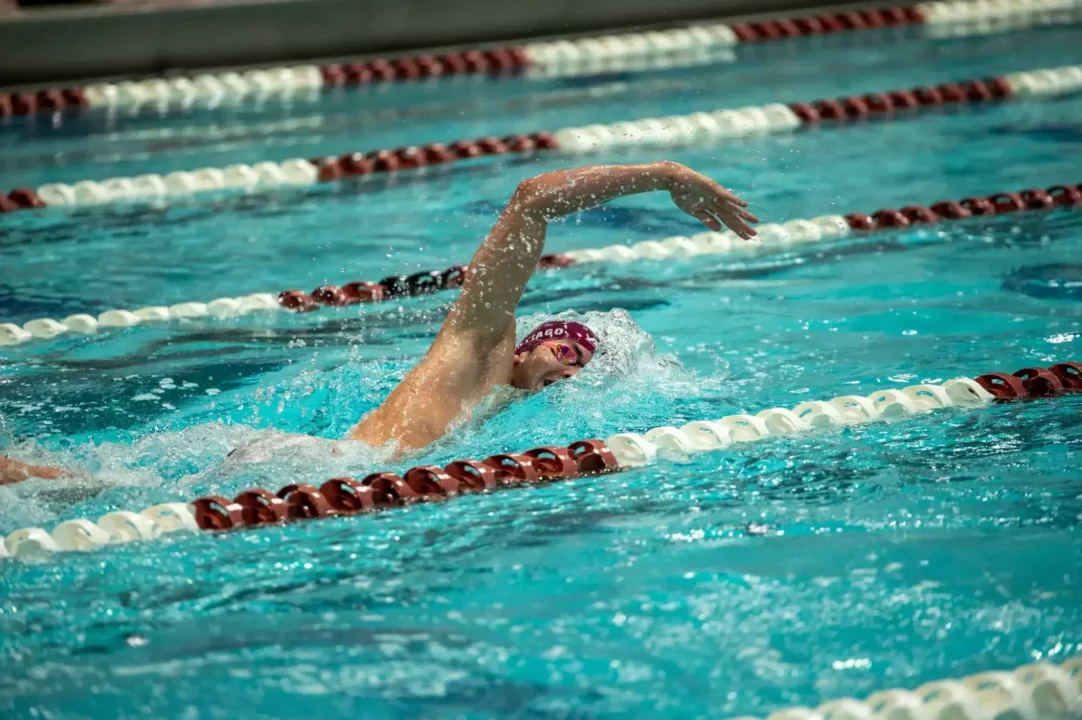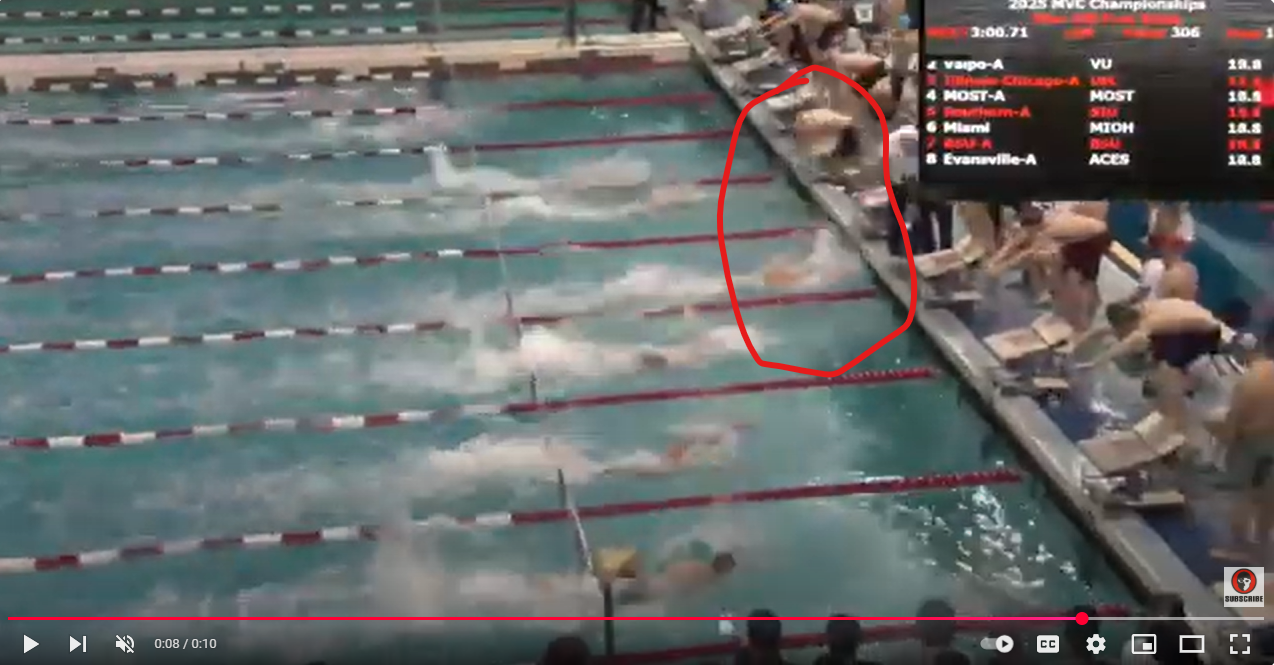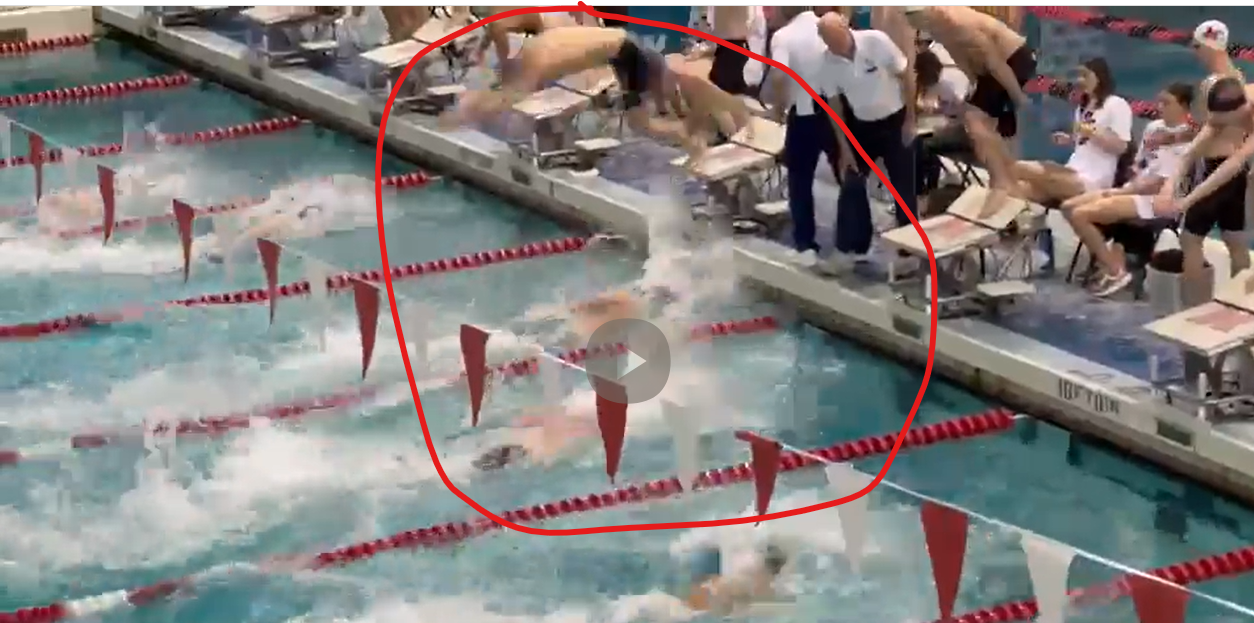2025 Missouri Valley Conference Championships (MEN)
- Dates: Wednesday, February 19–Saturday, February 22
- Location: Corwin M. Nixon Aquatic Center, Oxford, OH
- Defending Champions: N/A (inaugural event)
- Live Results (Available on MeetMobile)
- Live Video
- Championship Central
- Fan Guide
- Teams: Ball State*, Evansville*, Miami (OH)*, Missouri State*, Southern Illinois*, UIC*, Valparaiso*
- Results: Day 1 | Day 2 | Day 3
- Recaps: Day 1 | Day 2 | Day 3
A controversial disqualification of a record-breaking 200 free relay marred day 3 of the 2025 Missouri Valley Conference Championship meet.
The Salukis foursome of Alex Santiago, Donat Csuvarszki, Willem Huggins, and AJ Terry combined for a 1:17.45, which would have easily won the race by more than a second ahead of Miami, but Csuvarszki was called for an early exchange in spite of the touchpads officially registering a .22 second reaction time.
According to NCAA rules, “If the electronic relay takeoff equipment detects an exchange differential (takeoff pad time minus finish pad time) of –0.09 through +0.09 second inclusive from the manufacturer’s starting point, the decision(s) of the human judge(s) shall not be considered. The determination of the electronic relay takeoff equipment shall be official, with exchange differential of –0.09 through –0.01 second from the manufacturer’s starting point indicating a rules violation and values of 0.00 through +0.09 second indicating a legitimate relay exchange.
While it is unclear as to what the pads’ setpoint is (it ranges from -.05 to 0.00), a .22 reaction time is, visually, pretty easy to see from the naked eye. That equates to approximately a foot-and-a-half at 50 free speeds.
Because the registered reaction time was outside of the setpoints, it would have required dual confirmation from two officials of an early departure. The call was confirmed both by the official directly over the lane and the starter, five lanes away.
While we have seen issues with relay judging pads mar meets before (notably the 2023 Ivy League Championships, where several disqualifications were ultimately overturned), this is the opposite problem. With no other reported concerns over the function of the Relay Judging Pads (RJPs) at this meet, this is the opposite – a call that appears to have been missed by both judges.
See a video of the exchange in question below:
While the video is grainy, it is more than clear enough to capture the below frame where the swimmer in the water Alex Santiago almost has his head on the wall and the swimmer on the block Donat Csuvarszki is clearly still in contact with the surface.
While Santiago’s hand cannot be seen because of the wake, the video in motion combined with how close his head is to the wall paints a pretty clear picture that he had already made contact with the wall by this point of the race.
Another View:
Screenshots
The disqualification was a 46 point swing versus the Miami men, who finished the day with a 113 point lead.
Standings After Day 3:
- Miami University (Ohio) – 569
- Southern Illinois – 452
- Missouri State – 401
- UIC – 325.5
- Ball State – 237.5
- Valparaiso – 113
- Evansville – 79




Lol having a screenshot of a crappy quality livestream trying to prove that it was legal is pathetic. I don’t understand how anybody thinks that is a legal takeover.
i think you are looking at the incorrect part of the photo.
They missed a blatant flinch by SIU backstroker on first relay of meet.
You are 100% correct and it is super easy to see for anyone that goes and watches the Livestream of that race that is available.
For the 200 Medley Relay on Night #1, the SIU Backstroker made a blatant, major “flinch” right before the gun went off. I’m not sure how that winning SIU team didn’t get DQ’ed for that. I think it’s a reasonable argument that the SIU 200 Free Relay was unfairly penalized. And, for everyone understandably disappointed about that and commenting on this thread, I would think they should be equally disappointed in what happened that first night when SIU should have been DQ’ed for their 200 Medley Relay. I personally hate to see any team… Read more »
That’s a DQ
I’m glad the official that made the call could weigh in
anytime
I think the title for the article should be changed at there is nothing questionable about the call. It was wrong, plain and simple with evidence to show mistake was made. Officials make mistakes in other sports, and they try to figure out ways to make play fairer. It is clear a mistake was made; will the NCAA allow for a path to fix mistakes or will officials just be part of the sport and influence outcomes.
If Miami (OH) is going to keep pulling stunts like this, they named their aquatic center after the wrong M. Nixon.
Still wouldn’t change the fact that even if they didn’t call this Miami still wins the meet overall
How does that make two officials conspiring to deprive that SIU relay of its well-earned conference title acceptable? I have no horse in the Missouri Valley race, but if a relay with a valid +0.22 RJP getting DQed for early take-off doesn’t offend you then you don’t care about fair competition and clean sport.
Where’s the proof they conspired? Wild accusation to be making. You are accusing Miami of cheating.
I agree throwing out accusations of officials conspiring with Miami is the wrong argument here. What should be argued for is better judgment and accountability from the officiating crew, and proper procedures put in place to promote fairness at this level of the sport.
KCref and admin’s comments below show the major flaw in the procedures used at this year’s meet. If two officials can claim that a swimmer had an ETO despite the RJP and video showing a safe exchange (ultimately leading to a victory for the host team) it’s bound to raise questions of conspiracy. Whether that claim is true or false, the blame truly rests on the MVC’s shoulders for their failure to incorporate a video review… Read more »
I don’t actually believe that the Miami university swim team entered into a conspiracy with the officials. I couldn’t help but make a Nixon joke and “conspiring to deprive” was an unfortunate choice of words that should more appropriately be “combining to deprive” or similar. I apologize to the RedHawks for careless language and lack of good judgement. I don’t doubt to some extent that they are a victim of this decision, too.
Your last point is the important point, and all rules and procedures should be designed to preserve fair competition and reward athletes for their work. I wish no ill towards the officials. I personally assume they made a mistake. But I agree that it is on the… Read more »
Yes the reaction time was 0.22 but considering two officials called it at the same time is crazy which you don’t see very often
Is there nothing that can be done with this? Is it just an unfortunate event? Can the coaches take this to the NCAA and or who is held accountable? So theoretically the exchange could have been .70 and if the officials dual confirm there’s nothing that can be done? Doesn’t seem fair to the athletes that work all year for something like this to happen.
There’s really no mechanism for fixing a judge’s judgement if there’s no video replay system in place. There is a mechanism to declare RJPs faulty and overturn all of their DQs, but not the judges’ opinions.
home cookin’
They did the same thing last year at Miami-which is why they added GoPros. It’s insane. Why was this the only issue-nothing else with any other teams…
That was in 2023, but yes one would think that after the big DQ on the opening night, Coach Hanson would push for cameras moving forward. Maybe it’s the host team’s responsibility? Maybe the MVC should consider voting on requiring video evidence moving forward.
RedHawks would win no matter what…..no reason to cheat
I’d be losing my mind if I was SIU. Don’t know what the hell they’re looking at to not only have one official call it, but to dual confirm and override what looks to be an accurate .22 from the RJP.
There needs to be a safety net put in such as anything above .08 is automatically immune from officials as they must be drunk to make that call.
“a .22 reaction time is, visually, pretty easy to see from the naked eye” is simply not correct. The officials are trained to watch the foot depart the block, then look down and see if the hand is on the wall. A .22 exchange is barely enough time for the eyes to move and focus on the two different locations.
Officials that are not frequently exposed to tight exchanges with athletes swimming 19 second 50s will often get the calls wrong. At a mid-major conference meet like this, my guess is that many of the officials on deck spend most of their deck time watching age group swimmers. Officiating generally is not much different as the swimmers get faster, with… Read more »
That’s a good point re: officials who are less experienced with swims at this level.
I don’t know who the officials were, but I think it’s a good hypothesis.
I don’t think .22 is hard to see at any level past 10&U. Simple call, probably distracted officials
Other hypothesis is that one official made a mistake and the proper “blind confirmation” procedures weren’t followed.
I get one person having a brain fart, but both of them doing it…only thing I can see is that they were thrown off because it looked like he might go one stroke sooner, but if you see something that doesn’t make sense…just let the RJPs make the call.
It doesn’t matter that it looked like he might go one- stroker sooner.
It’s watch the feet leave, THEN look for the hand on the wall. Too many times officials screw up relay calls because they’re trying to watch the whole thing instead of focusing on the actual technical procedure.
This logic is faulty. You even outline the correct procedure. Foot to hand automatically makes it almost impossible for a .22 reaction time to be incorrectly judged. They are not trying to watch both simultaneously as you point out. Watching the foot leave, then the hand touch makes it so the benefit of the doubt should absolutely be on the athletes side. If a exchange has a .22 time the hand was absolutely securely on the wall before the officials eyes ever leave the foot.
The speed of the older athletes makes it absolutely without a doubt certain there shouldn’t be a call in this situation. The only reason an official would make this call is because they don’t know… Read more »
In theory, you are correct. The problem is found in neuroscience, I am in no way an expert, but it is an integral part of Human Factors training in many safety related industries. When something is very fast and very different from what you typically observe, the brain basically just invents pieces to tie the whole moment together. The observer won’t have a clue and will be 100% convinced that what they saw actually happened, it is in fact exactly what their brain showed them. This is why an official who does not observe this level of athlete on a regular basis could absolutely get this call wrong. Their brain is literally processing what they usually see as a 22… Read more »